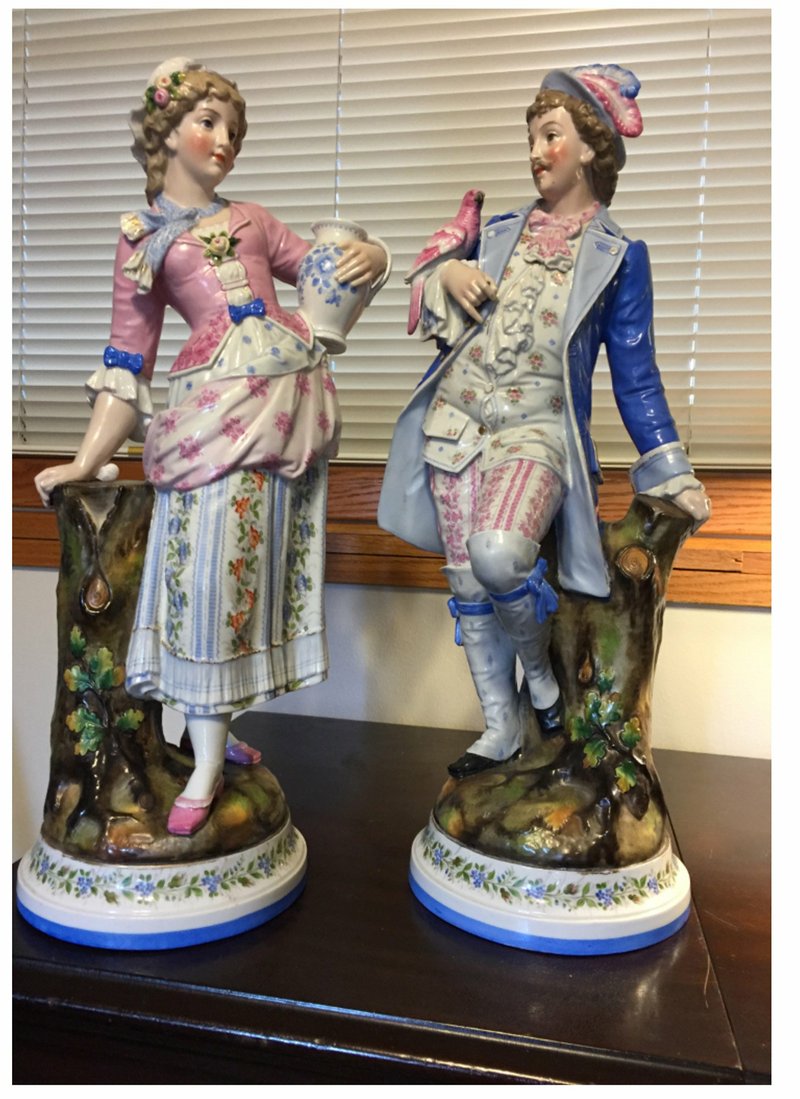DEAR HELAINE AND JOE: Perhaps you can identify these statues for us. We were told they were "Meissen" porcelain, but we have not been able to find ones with a similar mark on Google. We even checked eBay and found about 800 pieces labeled "Meissen," but none like ours. (With so many items for sale, it is evident that these are not trending treasures.) Each statue is 19 inches tall and in perfect condition. We tried researching the mark but could not identify it. Can you help?
— M. and L.M., Apple Valley, Minn.
DEAR M. AND L.M.: Trying to find answers on the Internet can be very frustrating. You must know what questions to ask, and for a novice that can be difficult, if not impossible.
In this case, M. and L.M. began their research with the name "Meissen," and this led them down a dead-end alley. Meissen, Germany, is where Johann Friedrich Bottger and Ehrenfried Walther von Tschirnhaus discovered the secret of making true Chinese-style hard paste porcelain, with the first experimental pieces made in 1708 and full-scale production beginning in 1710.
The discovery was actually made in Albrechtsburg castle in Meissen where Bottger was virtually the prisoner of Augustus II the Strong, elector of Saxony and king of Poland. Many years ago "Meissen" and "Dresden" were used almost interchangeably, but Dresden is a city located about 14 miles southeast of Meissen and is historically a center for decorating ceramics, not making them.
To answer today's question, a book of German marks is much more helpful than a computer. When we saw the photograph of the mark, we pulled down George Ware's German and Austrian Porcelain and within 30 seconds knew the pair of lovely porcelain figures was made in the town of Poessneck (sometimes spelled "Possneck" or "PoBneck"), which has a population of about 12,000 and is located in the German state of Thuringia.
The firm that made them is Conta and Boehme, which reportedly started making porcelain in 1790 and continued until the 1930s. The firm made household and decorative porcelains, as well as parts used in making dolls.
Poessneck is not a name that comes to the minds of most American collectors, and it has nothing to do with either Meissen or Dresden. The pair of figures belonging to M. and L.M. are certainly lovely, with their male and female figures leaning up against tree stumps. The clothing is nicely painted, and the bases are decorated with a garland of flowers.
But as M. and L.M. suspect, the items are not hugely popular with current collectors. Once upon a time, figures such as these would have been proudly displayed on a mantel or sideboard, but now they are considered by many to be too grandmotherly to fit into modern decor. Sad, but true.
At 19 inches tall and beautifully detailed, the figures are wonderful but only have a retail value in the $350 to $500 range.
Helaine Fendelman and Joe Rosson have written a number of books on antiques. Do you have an item you'd like to know more about? Contact them at Joe Rosson, 2504 Seymour Ave., Knoxville, TN 37917, or email them at treasures@knology.net. If you'd like your question to be considered for their column, please include a focused high-resolution photo of the subject with your inquiry.
HomeStyle on 04/06/2019
